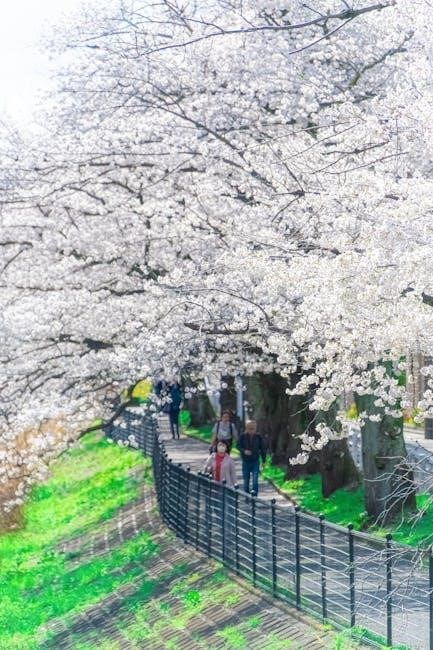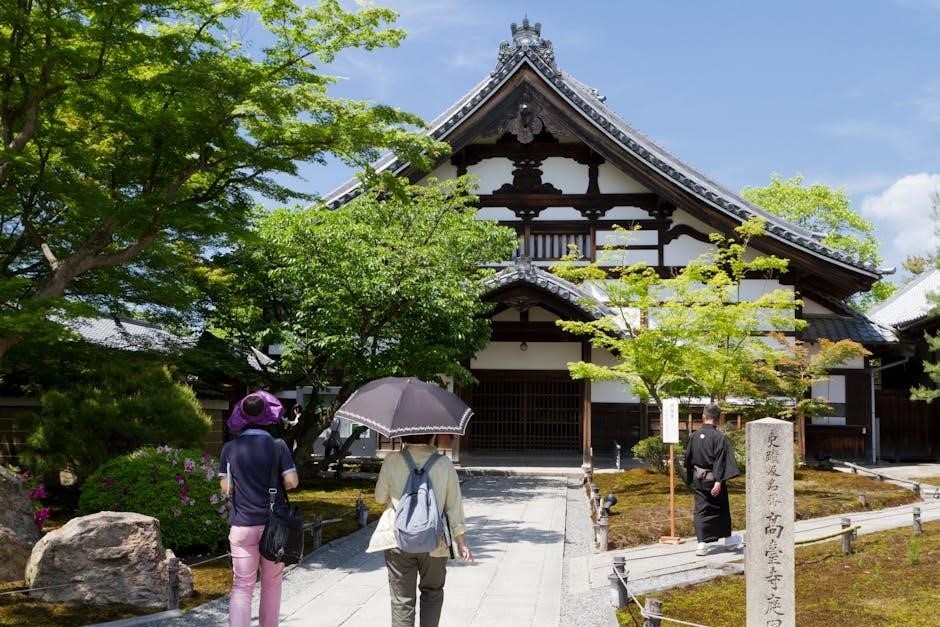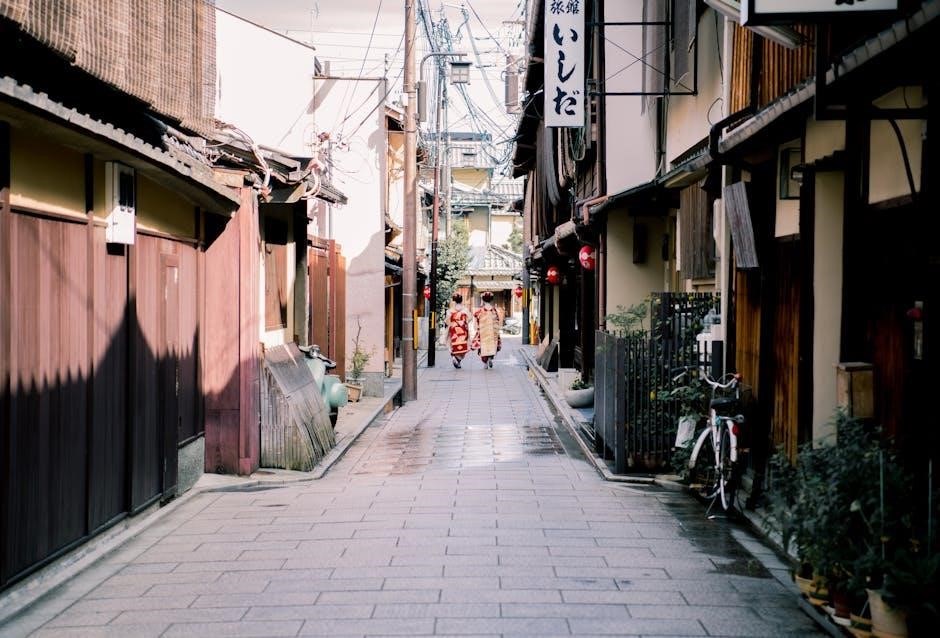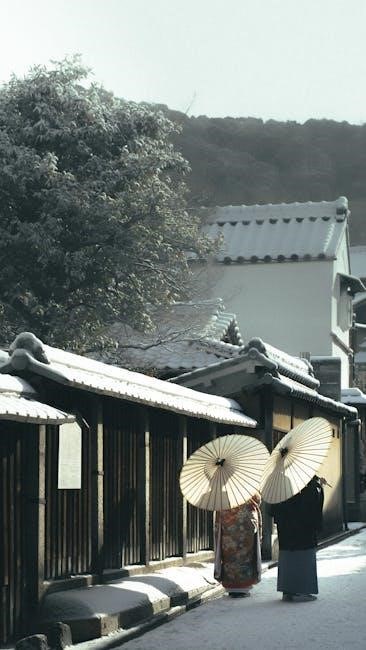Discover Japan at your own pace with self-guided walking tours, offering flexibility and independence to explore iconic trails like Kumano Kodo and Nakasendo, rich in history and nature.
What Are Self-Guided Walking Tours?
Self-guided walking tours are pre-planned travel packages designed for independent exploration. They include detailed itineraries, pre-booked accommodations, and transportation arrangements, allowing travelers to explore at their own pace. Unlike guided tours, self-guided options provide flexibility and independence, enabling participants to immerse themselves in local culture without a fixed schedule. These tours often feature iconic trails like the Kumano Kodo and Nakasendo, offering a mix of history, nature, and cultural experiences. With maps, navigation apps, and luggage transfers, self-guided tours make it easy to discover Japan’s hidden gems and scenic landscapes on your own terms.
Benefits of Self-Guided Tours vs. Guided Tours
Self-guided tours offer unparalleled flexibility, allowing travelers to explore at their own pace without the constraints of a group schedule. Unlike guided tours, self-guided options provide independence, enabling deeper immersion in local culture and nature. With pre-planned itineraries, detailed maps, and arranged accommodations, self-guided tours simplify logistics while maximizing freedom. They are ideal for independent travelers who prefer autonomy and the ability to personalize their experience. Additionally, self-guided tours often cost less than guided alternatives, making them a budget-friendly choice for those who still want support but value flexibility and solitude during their journey.
Popular Regions for Self-Guided Walking Tours in Japan
Explore Japans iconic trails, such as the UNESCO-listed Kumano Kodo, the historic Nakasendo Way, and the Shikoku 88 Pilgrimage, each offering unique cultural and natural experiences.
Kumano Kodo: UNESCO-Listed Pilgrimage Trails
The Kumano Kodo, a UNESCO World Heritage site, offers a timeless pilgrimage experience through Japans Kii Peninsula. These ancient trails, used for centuries, connect sacred shrines, temples, and villages, showcasing stunning natural beauty. Hikers can choose from 4 to 6-day self-guided tours, walking village to village through rural forests and dramatic landscapes. The trails are well-marked, with English signage, and tour operators like Oku Japan provide detailed itineraries and accommodations. Immersed in history and spirituality, visitors can explore iconic sites like Kumano Nachi Taisha and enjoy local cuisine, making it a must-do for cultural and nature enthusiasts.
Nakasendo Trail: A Journey Through Time and Nature
The Nakasendo Trail, an ancient route connecting Tokyo and Kyoto, offers a serene journey through Japans picturesque countryside. This historic trail, part of Japans Edo-period infrastructure, features charming villages, traditional inns, and breathtaking natural landscapes. Hikers can enjoy a 5-day self-guided tour, walking through dense forests, alongside waterfalls, and past rural hamlets. The trail is well-marked, with English signage, and tour operators like Walk Japan provide detailed itineraries, luggage transfers, and pre-booked accommodations. This trail is perfect for those seeking to immerse themselves in Japans history, culture, and untouched natural beauty at their own pace.
Planning Your Self-Guided Walking Tour
Plan your tour with detailed itineraries, pre-booked accommodations, and arranged transportation for a seamless experience, allowing you to focus on enjoying Japan’s diverse landscapes and cultural treasures.
Creating a Detailed Itinerary
Creating a detailed itinerary is crucial for a seamless self-guided walking tour in Japan. Start by mapping out your daily routes, considering trail lengths and highlights like temples or scenic viewpoints. Use resources from reputable tour companies or apps to plan accurately. Include flexibility for rest days or spontaneous detours. Research seasonal conditions and trail accessibility to ensure preparedness. Pack essential items like maps, navigation tools, and snacks. Pre-book accommodations along your route to avoid last-minute hassles. Balance cultural experiences, such as visiting shrines or trying local cuisine, with hiking time. A well-planned itinerary ensures a stress-free and enriching adventure.
Transportation and Accommodation Arrangements
Arrange transportation and accommodation in advance to ensure a smooth self-guided walking tour in Japan. Many tour operators provide detailed itineraries with pre-booked stays and luggage transfers. Utilize Japan Rail Passes for efficient travel between regions. Choose accommodations near trailheads or in traditional villages for convenience. Some companies offer bespoke navigation apps to guide you seamlessly. English signage in major areas and well-connected rural infrastructure make independent travel manageable. Pre-arranged logistics allow you to focus on enjoying the journey, immersing in cultural experiences, and connecting with nature without the hassle of last-minute planning.

Cultural and Historical Experiences

Explore Japan’s rich heritage by visiting iconic temples, shrines, and historical landmarks. Immerse yourself in local cuisine and traditions, experiencing the country’s vibrant culture firsthand.
Exploring Temples, Shrines, and Historical Landmarks
Self-guided walking tours in Japan offer a unique opportunity to explore iconic temples, shrines, and historical landmarks at your own pace. Discover the spiritual significance of UNESCO-listed sites like Kumano Kodo, where ancient pilgrimage trails lead to sacred shrines such as Kumano Nachi Taisha. Walk through historic villages and admire the architectural marvels of temples nestled in stunning natural landscapes. The Nakasendo Trail, for instance, features picturesque villages and serene forests, with landmarks like the Magome and Tsumago villages. These trails provide a seamless blend of nature and culture, allowing you to immerse yourself in Japan’s rich history and spirituality while enjoying breathtaking scenery.
Immersing in Local Cuisine and Traditions
A self-guided walking tour in Japan offers the perfect chance to delve into the country’s vibrant culinary culture and rich traditions. Savor local delicacies like fresh seafood, seasonal dishes, and regional specialties as you explore rural villages and bustling cities. Many tours include stays in traditional ryokans, where you can experience authentic kaiseki meals and relax in serene surroundings. Engage with local customs, such as tea ceremonies or traditional festivals, and enjoy the warm hospitality of the Japanese people. These immersive experiences allow you to deeply connect with Japan’s culture and create unforgettable memories of your journey.

Essential Items to Pack for Your Tour
Pack comfortable footwear, lightweight hiking gear, and navigation tools like maps or apps. Bring versatile clothing, a reusable water bottle, and local currency for incidentals.
Navigation Tools and Apps
Navigating Japan’s trails is made easier with essential tools like detailed maps, GPS-enabled devices, and bespoke navigation apps. Many popular routes, such as the Kumano Kodo and Nakasendo, feature clear signage in both Japanese and English. For added convenience, consider downloading apps like Google Maps or Maps.me, which often include offline functionality. Some tour operators provide custom navigation apps tailored to specific trails, ensuring you stay on track. Additionally, carrying a paper map and guidebook can serve as a reliable backup. Proper navigation tools are crucial for a smooth and enjoyable self-guided walking experience in Japan.
Comfortable Footwear and Hiking Gear
Comfortable footwear is essential for self-guided walking tours in Japan. Opt for sturdy, waterproof hiking shoes or trail runners with good support, as trails like the Kumano Kodo and Nakasendo feature uneven terrain. Moisture-wicking socks and extra pairs are recommended to keep feet dry and blister-free. A lightweight daypack with rain gear, snacks, and a water bottle is ideal for daily excursions. Trekking poles can provide stability on challenging sections. Many tour operators offer luggage transfers, allowing you to hike unencumbered. Durable, weather-appropriate clothing and layers for varying temperatures are also vital for a comfortable journey through Japan’s diverse landscapes.

Safety Tips for Self-Guided Walkers
Carry navigation tools, understand trail markings, and use apps for unclear signage. Plan for emergencies and stay informed about local conditions to ensure a safe journey.
Understanding Trail Markings and Signage
Japan’s trails, such as the Kumano Kodo and Nakasendo, are well-marked with bilingual signage, making navigation straightforward. Many paths feature clear directional signs in both Japanese and English, ensuring walkers can follow the route easily. In areas where signage is less clear, utilizing navigation apps or GPS tools can help maintain direction. These trails often include markers indicating distances, landmarks, and points of interest, enhancing the walking experience. Understanding these markings is essential for a smooth journey, allowing walkers to focus on enjoying the scenic beauty and cultural heritage of Japan’s historic pilgrimage routes.
Preparing for Emergency Situations
When embarking on a self-guided walking tour in Japan, it’s essential to be prepared for emergencies. Carry a first-aid kit, water, snacks, and a portable charger for your devices. Familiarize yourself with local emergency contact numbers, including 110 for police and 119 for medical services. Many trails, like the Kumano Kodo, have well-maintained infrastructure, but rural areas may have limited facilities. Carry a map or use a GPS app as a backup. Inform your accommodation provider of your itinerary and expected return time. Check weather forecasts to avoid unexpected conditions and have a plan for seeking shelter if needed.
A self-guided walking tour in Japan offers a unique, flexible way to immerse yourself in its culture, history, and natural beauty, creating unforgettable memories at your own pace.
Final Tips for a Memorable Self-Guided Adventure
For a memorable self-guided adventure in Japan, plan meticulously with detailed itineraries and essential navigation tools. Pack lightweight, comfortable footwear and layers for varying weather. Arrange luggage transfers to enjoy hassle-free walking. Stay flexible, allowing time to immerse in local culture and traditions. Respect historical sites and natural environments by following trail etiquette. Carry a basic emergency kit and stay informed about weather conditions. Embrace the freedom to explore at your own pace, engaging with locals and savoring authentic cuisine. With careful preparation and an open mind, your self-guided journey will create lifelong memories of Japan’s stunning landscapes and rich heritage.
